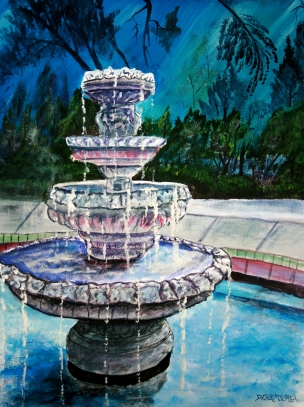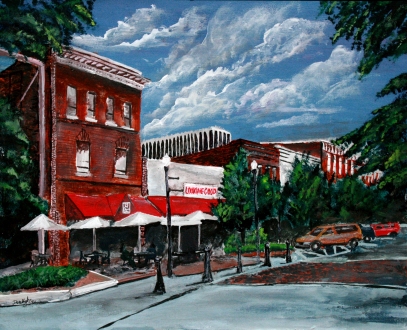Acrylic Paintings Definition
Source(Google.com.pk)
Acrylic paint is fast drying paint containing pigment suspension in acrylic polymer emulsion. Acrylic paints can be diluted with water, but become water-resistant when dry. Depending on how much the paint is diluted (with water) or modified with acrylic gels, media, or pastes, the finished acrylic painting can resemble a watercolor or an oil painting, or have its own unique characteristics not attainable with other media.
As soon as 1934 the first usable acrylic resin dispersion was developed by German chemical company BASF, which was patented by Rohm and Haas. Between 1946 and 1949, Leonard Bocour and Sam Golden invented a solution acrylic paint under the brand Magna paint. These were mineral spirit-based paints. Acrylics were made commercially available in the 1950s. A waterborne acrylic paint called "Aquatec" would soon follow. Otto Rohm invented acrylic resin, which quickly transformed into acrylic paint. In 1953, the year that Rohm and Haas developed the first acrylic emulsions, Jose L. Gutierrez produced Politec Acrylic Artists' Colors in Mexico, and Permanent Pigments Co. of Cincinnati, Ohio, produced Liquitex colors. These two product lines were the very first acrylic emulsion artists' paints. Water-based acrylic paints were subsequently sold as latex house paints, as latex is the technical term for a suspension of polymer microparticles in water. Interior latex house paints tend to be a combination of binder (sometimes acrylic, vinyl, pva, and others), filler, pigment, and water. Exterior latex house paints may also be a co-polymer blend, but the best exterior water-based paints are 100% acrylic, due to elasticity and other factors, but vinyl costs half of what 100 percent acrylic resins cost, and PVA (polyvinyl acetate) is even cheaper, so paint companies make many combinations of them to match the market.
Soon after the water-based acrylic binders were introduced as house paints, artists and companies alike began to explore the potential of the new binders. Water-soluble artists' acrylic paints became commercially available in the 1950s, offered by Liquitex, with high-viscosity paints similar to those made today becoming available in the early 1960s. In 1963, Rowney (now part of Daler-Rowney since 1983) was the first manufacturer to introduce an artist’s acrylic color in Europe, under the brand name Cryla.
Techniques
Main article: Acrylic painting techniques
Acrylic artist paints may be thinned with water and used as washes in the manner of watercolor paints, but the washes are not re-hydratable once dry. For this reason, acrylics do not lend themselves to color lifting techniques as do gum arabic based watercolor paints.
Acrylic paints with gloss or matte finishes are common, although a satin (semi-matte) sheen is most common; some brands exhibit a range of finish (e.g., heavy-body paints from Golden, Liquitex, Winsor & Newton and Daler-Rowney). Politec acrylics are fully matte. As with oils, pigment amounts and particle size or shape can naturally affect the paint sheen. Matting agents can also be added during manufacture to dull the finish. The artist can mix media with their paints and use topcoats or varnishes to alter or unify sheen if desired.
Only a proper, artist-grade acrylic gesso should be used to prime canvas in preparation for painting with acrylic (however, acrylic paint can be applied to raw canvas if so desired without any negative effect or chemical reaction as would be the case with oils). It is important to avoid adding non-stable or non-archival elements to the gesso upon application. However, the viscosity of acrylic can successfully be reduced by using suitable extenders that maintain the integrity of the paint film. There are retarders to slow drying and extend workability time and flow releases to increase color-blending ability.
Acrylic Paintings Pictures Galleries Wallpaper Paintings

Acrylic Paintings Pictures Galleries Wallpaper Paintings


Acrylic Paintings Pictures Galleries Wallpaper Paintings


Acrylic Paintings Pictures Galleries Wallpaper Paintings


Acrylic Paintings Pictures Galleries Wallpaper Paintings


Acrylic Paintings Pictures Galleries Wallpaper Paintings


Acrylic Paintings Pictures Galleries Wallpaper Paintings

Acrylic Paintings Pictures Galleries Wallpaper Paintings

Acrylic Paintings Pictures Galleries Wallpaper Paintings

Acrylic Paintings Pictures Galleries Wallpaper Paintings

No comments:
Post a Comment